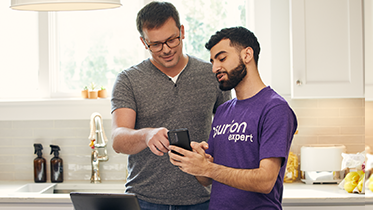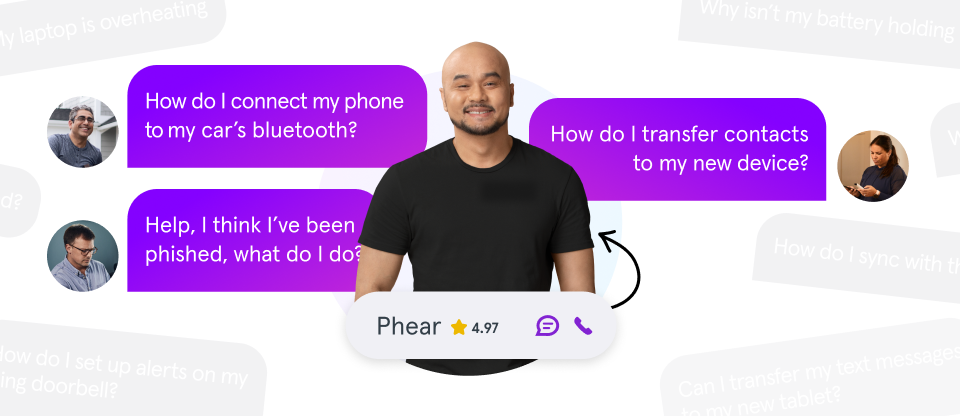Thanks to online shopping, you can buy pretty much anything, anytime you want. Yet cybercriminals are often lurking, looking for ways to steal your credit card information. Don't worry—we can help.
At Asurion, our experts provide our 300 million customers with solutions for all of their tech care needs, including digital security. Whether you're looking to protect your phone from hackers or secure your device after it's been compromised, our experts are available 24/7.
Here are their tips on how to protect your credit card information online.
Only use secure Wi-Fi networks
Using the public Wi-Fi available at airports and coffee shops is fine for scrolling social media or reading the news, but any information you send or receive while shopping online could be intercepted by someone else. We recommend you wait to buy anything until you're on a trusted home network—and if you can't—turn off your Wi-Fi and use mobile data while making your purchase.
For more information, here's our guide to staying safe on public Wi-Fi.
Create strong passwords for online accounts
Our next credit card security tip involves using strong passwords for all your online accounts. The most secure passwords are long and include upper- and lower-case letters, numbers, and symbols. when creating one, don't incorporate personal information (like birthdays and street addresses) and avoid sequential letters (like abcd) and numbers as well as common words (like password).
To learn more, read our guide to creating strong passwords.

Don’t waste time scrolling
Life is short. Ask our experts and get answers now.
Use secure payment methods
Third-party digital wallets, like Apple Pay®, Google Pay®, and Paypal®, turn your device into a credit or debit card, enabling you to shop in person, online, even in taxis without using a physical card.
Digital wallets offer added protection by withholding your credit card information from the seller, creating a one-time account number for every purchase you make. So if the merchant gets hacked, your credit card info will be safe.
To learn more about digital payment systems, read our guide to Apple Pay.
Use legitimate known websites
The safest way to pay online is to use trusted, reputable retailers. If a site is unknown to you, here are some tips:
- Research the company and read customer reviews to be sure there aren't a lot of complaints about service, products, or security.
- If someone sends you a link to a product online, navigate to the website independently—not by clicking the link. Doing so will help you avoid phishing scams.
- Double-check that the address, or URL, contains the company's name, not a slightly different version of the correct spelling (the latter is a sign that you're on an unsafe website).
Only trust secure websites
You'll know a website is safe if the URL starts with “https” instead of “http.” The “s” means the website uses encryption to hide your payment information from potential data thieves. You should also look for the lock icon in the browser's URL field.
Designate one account for online shopping
Another way to improve credit card safety is to use a single card for all your online shopping. Using multiple cards increases the chance of being hacked, plus it's harder to keep track of what you buy.
Another tip: Instead of creating online accounts and storing your card info, always check out as a guest.
Set up account alerts and two-factor authentication
Two-factor (or two-step) authentication is a security tool that sends you a unique code anytime you sign in to your account from an unknown device. Without that code, you can't sign in. So even if a hacker gets your credit card login info, two-factor authentication ensures they won't be able to use it. If you don't use two-factor authentication, here's our guide to what it is and how to set it up.
Sign up for email or text alerts
Many credit cards give you the option to sign up for email or text alerts whenever a purchase is made. This way, you'll know about an unauthorized purchase as soon as it occurs. You can also set up alerts for when your balance dips below a certain number or a transaction exceeds a certain amount.
Update your browsers and antivirus software
Updating your apps and operating system helps your device run more smoothly. These updates also include security patches that keep your tech safer. So anytime you receive an update notification, don't wait—download it, stat.
Keep your personal information current
If you move or change your phone number, notify your bank and credit card company right away to ensure your statements follow you wherever you go, instead of going to someone else. This also helps your bank and credit card company reach you easily if they learn about fraudulent activity.
Check credit card account and statements
Check your credit card statements regularly—especially after you make a purchase—and keep an eye out for suspicious charges both large and small. Sometimes, thieves will make small charges every month, thinking you won't notice. If you do spot a suspicious charge, report it to your bank or credit card company immediately.
When it comes to online shopping, there isn't one way to protect yourself 100% of the time. But following these tips will significantly reduce your risk.
Tried these steps and still need help? We got you. Get your tech problem solved when you call or chat with an expert now.





